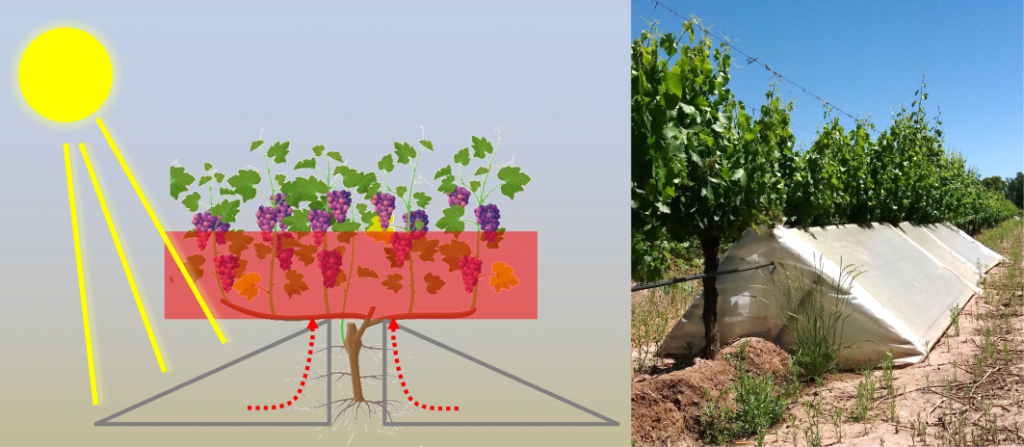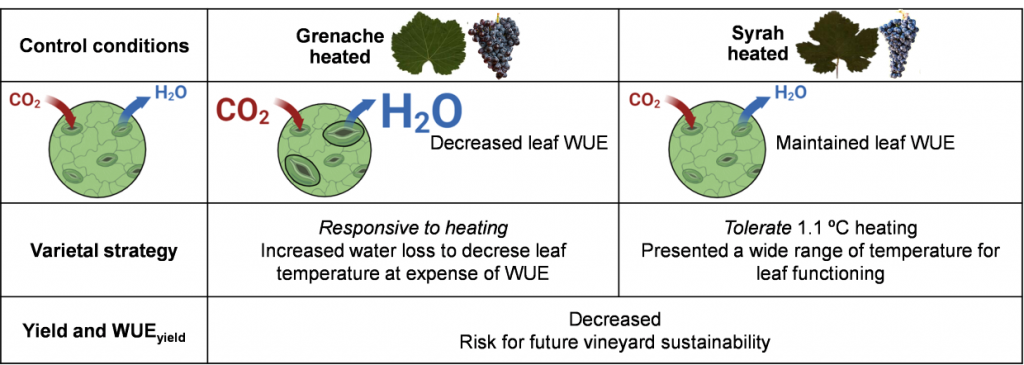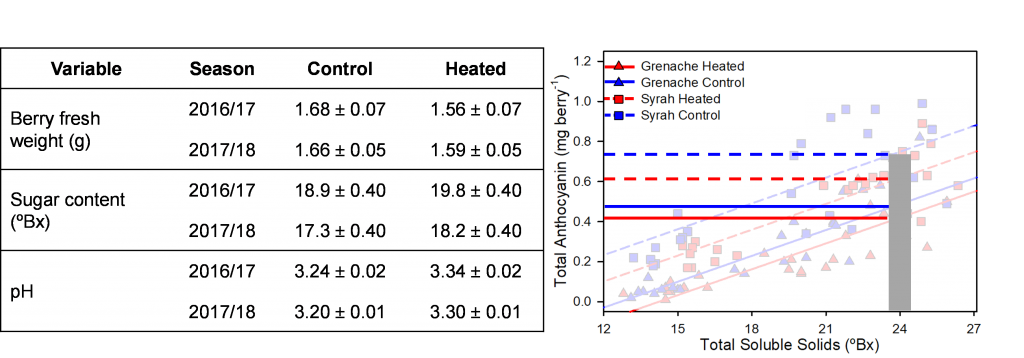By Agustina E. Gallo, Marianela Bustos Morgani, Martin Fanzone, Santiago Sari, Carina V. González, Jorge E. Perez Peña, Jorge A. Prieto.
1For the complete study see Gallo, A. E., Perez Peña, J. E., González, C. V. and Prieto, J. A. Syrah and Grenache (Vitis vinifera) revealed different strategies to cope with high temperature. Australian Journal of Grape and Wine Research (2022) doi:10.1111/ajgw.12530.
Introduction
Climate change will affect natural and cultivated systems worldwide. For Mendoza, the main grape-growing region of Argentina, some studies predict an increase in mean air temperature between 2 and 4 ºC by the end of this century (Cabré et al., 2016). Additionally, it is also projected that snow precipitation in the Andean region will decrease, which is the unique water source for agriculture and other human activities (Boninsegna, 2014). A warmer environment may increase water consumption at plant level. This scenario (higher temperatures and less water availability) may jeopardize vineyard sustainability. Increasing water use efficiency (WUE, the amount of C gain relative to water loss) is a relevant target to mitigate climate change impact.
Plant transpiration is the process by which water is lost as vapor, mainly from the leaves to the atmosphere. The water evaporation decreases leaf temperature to maintain a proper leaf metabolism. Leaf transpiration is partially regulated by stomata, which are pores on the downside face of grapevine leaves that consist of two specialized cells flanking a central aperture (Dow et al., 2014). Stomata control the leaf gas exchanges: water vapor loss and carbon dioxide gain. Grapevines present variability in the response of stomata to environmental factors, which are variety dependent (Chaves et al., 2010). The most well documented mechanism is the response to water deficit, from which grapevine varieties are classified as anisohydric or isohydric. Syrah and Grenache are respectively the two model varieties of these responses to water stress (Schultz, 2003). Conversely, mechanism in response to temperature have not been studied as much.
Temperature also strongly affects berry ripening and wine quality. In several viticultural regions around the world, warmer temperatures have been associated with higher sugar concentration, less acidity and less anthocyanin content (which are responsible for red wine’s color and flavor) at harvest (Mira de Orduña, 2010). In addition, sugar accumulation starts earlier in the season and is decoupled from anthocyanin. These changes might negatively affect wine quality. Nevertheless, some varieties have been less responsive to warming and have maintained berry quality in hotter environments.
In this study, we aimed to study the stomatal response to warming and its impact on water use efficiency at the leaf and whole plant level in two varieties with contrasting stomatal behavior and also the effects on berry composition.
Material and methods
We conducted a field experiment, in a vineyard located at INTA Experimental Station Mendoza. We compared Syrah and Grenache plants under control conditions with plants exposed to a passive heating from budburst to harvest. Figure 1 describes the heating system, developed previously by Sadras and Soar (2009). Plants were maintained under well-watered conditions during the whole growing season. We measured air and leaf temperature to characterize temperature treatments. We also evaluated carbon assimilation (An), stomatal conductance (gs), intrinsic leaf water use efficiency (WUEint) and yield water use efficiency (WUEyield). WUEint is the ratio An/gs and WUEyield is the ratio between plant yield and total amount of water applied by irrigation during the season. We also measured stomata (pore) length. Additionally, we followed berry ripening from veraison to harvest by measuring sugar content (ºBx), pH and berry fresh weight (g). Total anthocyanin content was determined at veraison, mid-ripening and harvest. Gas exchange and stomatal measurements were conducted in 2016/17 growing season. Berry ripening and WUEyield were assessed in 2016/17 and additionally in 2017/18.
Results and discussion
Heating system increased in average 1.1 ºC mean air temperature, respect to control conditions from October to March (south hemisphere grapevine growing season) in 2016/17 season. During leaf development, plants were exposed to an increase of 1.4 ºC. For the 2017/18 season, mean temperature increase was 2.7 ºC. These values are in accordance with some climate change predictions for Mendoza grape-growing regions as for others around the world (Cabré et al., 2016; Santillán et al., 2019). In each variety, heating system also increased leaf temperature. However, as plants were under well water conditions, leaves could track air temperature and maintained their functioning.

Figure 1. Left: Passive heating system. It consisted of polycarbonate sheets that form a small tent under the canopy, with a zenithal opening. Solar radiation heats the air inside the tent, the hot air rises and increases the canopy temperature. Right: Panels installed in Grenache plants at the vineyard. INTA Experimental Station, Mendoza, Argentina, 2017.
Varieties showed different responses to heating in leaf gas exchange. Grenache increased An and gs under heating, but this led to a decrease in WUEint. In this variety, longer stomata were more frequent in the heated plants, respect to control. This suggests that heating since the beginning of leaf development (i.e. budburst) led to anatomical changes in Grenache, with its correspondent physiological response: higher An and gs. Syrah, on the other hand, maintained WUEint under both, control or heating conditions, because An and gs were not modified, neither stomatal length. Importantly, WUEyield decreased under warmer conditions in both varieties in the two seasons evaluated. As the amount of water applied was the same for all treatments, WUEyield decrease was due to yield loss. This would indicate that in a hotter environment, for the same amount of water applied, yield will decrease. These results are summarized in Figure 2.

Figure 2. Summary of heating effects on Grenache (left) and Syrah (right) field grown plants. A different strategy to cope with heating was defined in each variety.
In addition, berry ripening was affected by heating in both varieties. Grape from heated plants had lower berry fresh weight (only in 2016/17 season) and higher sugar content and pH in both season evaluated (left table in Figure 3). When we compared anthocyanin respect to sugar, we obtained in heated grapes of both varieties a lower total anthocyanin:sugar content ratio (right panel in Figure 3). This situation (higher sugar and pH, lower anthocyanin) is common in warm regions and might intensify in the future, negatively affecting berry and wine composition and aging.

Figure 3. Summary of heating effect on berry fresh weight and composition. Heating increased sugar content and pH, and decreased berry fresh weight (left table); and decreased total anthocyanin content, for a same amount of sugar (right panel).
Conclusions
In this work, we found that Grenache was more responsive to increasing temperature. It modified its leaf functioning by increasing gs and thus loosing water to cope with heating. This led to an increase of An but to a lesser extent, so WUEint decreased, respect to control plants. On the other hand, Syrah behave as a tolerant variety, since it maintained its leaf functioning under control and heated conditions. Probably, the degree of temperature increase achieved in this study (1.1 ºC on average) is within the range of temperature that Syrah can tolerate without modifying its behavior. Nevertheless, WUEyield decreased in both varieties. When extrapolations from leaves WUE to whole plant WUE are done, some contrasting results may appear, as for Syrah in this case. Water losses and respiration from trunks, roots or grapes are not considered when WUE is measured at the leaf level (Tomás et al., 2014). In addition, berry composition was negatively affected in both varieties. Some canopy management strategies are being studied in order to delay berry ripening and avoid the hottest months in summer, such as late pruning (Bustos Morgani et al., 2022), severe shoot trimming, leaf removal or shading nets, among others (Gutiérrez-Gamboa et al., 2021). Further studies combining heating and water deficit treatments are needed, considering the contrasting behaviors of these two varieties.

Agustina Eugenia Gallo
I’m an Agricultural Engineer (2009-2015) and a PhD in Agronomy (2016-2022). I conducted my PhD thesis at Instituto Nacional de Tecnología Agropecuaria (Mendoza, Argentina). I’ve specialized in the study of climate change effects on grapevine physiology. I also work teaching viticulture at Universidad Tecnologica Nacional.
Marianela Bustos Morgani
I am Agricultural Engineer, graduated with honors from the Facultad de Ciencias Agrarias (FCA) at Universidad Nacional de Cuyo (UNCuyo). I have recently submitted my PhD thesis titled “Delayed pruning as a strategy for adaptation to climate change in the Malbec variety (Vitis vinifera) in Mendoza, Argentina”. More specifically, the objective of my study was to evaluate the effect of late pruning on the phenology, vegetative development, water consumption, yield components and berry and wine composition in the Malbec variety. My PhD thesis work was made at INTA Mendoza, in the area of vine ecophysiology and it was carried out with a CONICET doctoral scholarship. I am also dedicated to teaching at tertiary level, in the area of crop and fruit production; and I have worked at university level in viticulture at the FCA.
Martin Fanzone
Degree in Food Science (Universidad Nacional de Cuyo, Argentina), Master and PhD in Enology and Biotechnology (Universidad Rovira i Virgili, Spain). Since 2002, he has been a researcher at the Instituto Nacional de Tecnología Agropecuaria (INTA, Argentina), and since 2015 he has been a member of the Science and Technical management team, project manager, and researcher at Universidad Juan Agustín Maza (Argentina). Expertise in instrumental analytical chemistry (gas and liquid phase chromatography, mass spectrometry, UV-Visible spectrophotometry); research methodology; experimental design; validation of analytical methodologies; enological chemistry and technology; and sensory analysis. Author of more than 35 publications in indexed scientific journals and numerous communications in national and international scientific and technological events. He teaches undergraduate and graduate courses at public and private universities and is the director of graduate theses.
Santiago Sari
I’m Agronomic Engineer from Facultad de Ciencias Agrarias, Universidad Nacional de Cuyo (Mendoza, Argentina). I’m researcher in oenological technology at the pilot winery at INTA EEA Mendoza from 2002. I have participated in projects and teaching at national and international level. I have coauthored 22 scientific papers, divulgation articles, and more than 50 communications in national and international scientific events. I do teaching in graduate and postgraduate careers at the Universidad Nacional de Cuyo and Universidad Tecnológica Nacional.
Carina V. Gonzalez
I’m Agronomic Engineer from Facultad de Ciencias Agrarias, National University of Cuyo (Mendoza, Argentina). I obtained my PhD degree in the same University. I did a posdoc in the University of Bolzano in Italy. Currently, I’m a Professor of Plant Physiology at Facultad de Ciencias Agrarias, National University of Cuyo and a CONICET researcher at IBAM (Instituto de Biologia de Mendoza). I work on grapevine ecophysiology in aspects related to sustainable vineyard management and its impacts on the main physiological processes involved in berry and wine composition. I’m advisor and co-advisor of PhD students from CONICET and University of Bolzano students. I have coordinated national research projects from MINCYT and National University of Cuyo.
Contact: cgonzalez@fca.uncu.edu.ar
Jorge Perez Peña
Researcher at Mendoza Experimental Station of the National Institute of Agricultural Technology of Argentina. He obtained his first degree from the Agronomy College at the University of Buenos Aires, a Master of Science in Irrigation and Drainage at the University of Cuyo and his Ph.D. at Washington State University in the USA. His main interests and research topics are related to vine ecophysiology, vineyard irrigation and climate change.
Jorge Alejandro Prieto
Agronomic Engineer from Facultad de Ciencias Agrarias, Universidad Nacional de Cuyo (Mendoza, Argentina), Ms Degree on Viticulture and Oenology and Biology Doctor both from Montpellier SupAgro (France). Researcher in grapevine ecophysiology in aspects related to vineyard management, irrigation, genetic diversity, adaptation to climate change, and its impacts on the main physiological processes involved in berry and wine composition. Advisor and co-advisor of doctorate and master theses from INTA and CONICET students. Coordinator of national research projects at INTA and MINCYT and main professor of Viticulture at the Licenciatura of Enología in Maza University.
Contact: prieto.jorge@inta.gob.ar
References
References
Boninsegna, J.A., 2014. Impacto del Cambio Climático en los oasis del oeste argentino. Ciencia e Investigación 64–1, 45–58.
Bustos Morgani, M., Perez Peña, J.E., Fanzone, M., Prieto, J.A., 2022. Pruning after budburst delays phenology and affects yield components, crop coefficient and total evapotranspiration in Vitis vinífera L. cv. ‘Malbec’ in Mendoza, Argentina. Scientia Horticulturae 296, 110886. https://doi.org/10.1016/j.scienta.2022.110886
Cabré, M.F., Solman, S., Núñez, M., 2016. Regional climate change scenarios over southern South America for future climate (2080-2099) using the MM5 Model. Mean, interannual variability and uncertainties. Atmosfera 29, 35–60. https://doi.org/10.20937/ATM.2016.29.01.04
Chaves, M.M., Zarrouk, O., Francisco, R., Costa, J.M., Santos, T., Regalado, A.P., Rodrigues, M.L., Lopes, C.M., 2010. Grapevine under deficit irrigation: hints from physiological and molecular data. Annals of Botany 105, 661–676. https://doi.org/10.1093/aob/mcq030
Dow, G.J., Bergmann, D.C., Berry, J.A., 2014. An integrated model of stomatal development and leaf physiology. New Phytologist 201, 1218–1226. https://doi.org/10.1111/nph.12608
Gutiérrez-Gamboa, G., Zheng, W., Martínez de Toda, F., 2021. Current viticultural techniques to mitigate the effects of global warming on grape and wine quality: A comprehensive review. Food Research International 139, 109946. https://doi.org/10.1016/j.foodres.2020.109946
Mira de Orduña, R., 2010. Climate change associated effects on grape and wine quality and production. Food Research International 43, 1844–1855. https://doi.org/10.1016/j.foodres.2010.05.001
Sadras, V.O., Soar, C.J., 2009. Shiraz vines maintain yield in response to a 2-4 °C increase in maximum temperature using an open-top heating system at key phenostages. European Journal of Agronomy 31, 250–258. https://doi.org/10.1016/j.eja.2009.09.004
Santillán, D., Iglesias, A., La Jeunesse, I., Garrote, L., Sotes, V., 2019. Vineyards in transition: A global assessment of the adaptation needs of grape producing regions under climate change. Science of the Total Environment 657, 839–852. https://doi.org/10.1016/j.scitotenv.2018.12.079
Schultz, H.R., 2003. Differences in hydraulic architecture account for near- isohydric and anisohydric behaviour of two field-grown Vitis vinifera L. cultivars. Plant, Cell and Environment 26, 1393–1405. https://doi.org/10.1046/j.1365-3040.2003.01064.x
Tomás, M., Medrano, H., Escalona, J.M., Martorell, S., Pou, A., Ribas-Carbó, M., Flexas, J., 2014. Variability of water use efficiency in grapevines. Environmental and Experimental Botany 103, 148–157. https://doi.org/10.1016/j.envexpbot.2013.09.003

